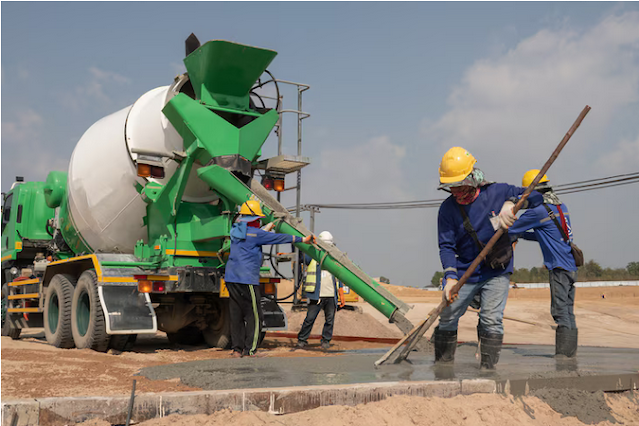Pump it Right: Mastering the Art of Concrete Pumping Services
Introduction:
In the realm of modern construction, efficiency and precision are paramount, and concrete pumping services have emerged as a transformative technology that addresses both these aspects. This article delves into the art of concrete pumping services, exploring the technology, its applications, the mastery required for effective implementation, and the overarching benefits it brings to construction projects.
Understanding Concrete Pumping Services:
Concrete pumping services involve the use of specialized equipment to transport and place concrete accurately at construction sites. This method has revolutionized the way concrete is delivered, allowing for efficient placement in various locations, including high-rise buildings, foundations, and challenging terrain. The two main types of concrete pumps, boom pumps and line pumps, offer distinct advantages based on project requirements.
The Technology Behind Concrete Pumping:
Boom Pumps: Boom pumps are equipped with a hydraulic arm, or boom, that allows for precise placement of concrete at varying heights and distances. This technology is particularly beneficial for tall structures, such as skyscrapers, where the concrete needs to be delivered to different floors.
Line Pumps: Line pumps are versatile and suitable for horizontal pumping. They use flexible hoses to transport concrete to the desired location. Line pumps are ideal for projects with varying elevation levels and provide a more flexible and adaptable solution.
Mastery of Concrete Pumping Services:
Equipment Operation: Mastery of concrete pumping services begins with a deep understanding of equipment operation. Operators must be skilled in controlling the boom or directing the line to ensure accurate and efficient concrete placement.
Safety Protocols: Safety is paramount in concrete pumping services. Mastery involves rigorous adherence to safety protocols, including proper equipment setup, securing the work area, and maintaining clear communication between operators and other construction personnel.
Site Assessment: Successful concrete pumping requires a thorough assessment of the construction site. Mastery involves evaluating access points, site conditions, and potential obstacles to determine the most effective setup for the concrete pump.
Mix Design Considerations: Mastery extends to understanding concrete mix designs and their implications on pumping. Different mixes may have varying flow characteristics, and operators must be well-versed in adapting to these variations for optimal performance.
Applications of Concrete Pumping Services:
High-Rise Construction: Concrete pumping services are indispensable in high-rise construction projects where the efficient delivery of concrete to upper floors is challenging using traditional methods. Boom pumps are particularly well-suited for such applications.
Foundations and Footings: The precise placement capabilities of concrete pumping services make them ideal for laying foundations and footings. This ensures uniform and consistent concrete distribution, contributing to the structural integrity of the building.
Infrastructure Projects: Infrastructure projects, such as bridges and tunnels, often involve challenging terrains and locations. Concrete pumping services enable the efficient delivery of concrete to these sites, overcoming geographical obstacles.
Residential Construction: In residential construction, where space constraints and landscaping considerations are prevalent, concrete pumping services offer a solution for accurate concrete placement. Line pumps are commonly used for driveways, patios, and other residential applications.
Benefits of Concrete Pumping Services:
Time Efficiency: One of the primary benefits of concrete pumping services is the significant time savings they offer. The precise placement of concrete eliminates the need for manual labor-intensive methods, expediting the construction process.
Cost-Effective: While concrete pumping services may involve an initial investment, they prove to be cost-effective in the long run. The efficiency and speed they bring to construction projects result in reduced labor costs and overall project expenses.
Reduced Manual Labor: Concrete pumping minimizes the need for extensive manual labor in the concrete placement process. This not only contributes to time efficiency but also enhances on-site safety by reducing strenuous physical labor.
Enhanced Precision: The technology behind concrete pumping services allows for unparalleled precision in concrete placement. This precision ensures uniformity, reduces material waste, and contributes to the overall quality and durability of the construction.
Versatility: Concrete pumping services are versatile and adaptable to various construction scenarios. Whether it's a high-rise project, a residential build, or an infrastructure endeavor, the technology can be customized to meet specific requirements.
Conclusion:
Mastering the art of concrete pumping services is a multifaceted endeavor that involves technological proficiency, safety adherence, and a deep understanding of construction dynamics. As technology continues to advance, concrete pumping services have become a cornerstone in the construction industry, offering a solution that aligns with the demands of modern projects.
The benefits of concrete pumping services, including time efficiency, cost-effectiveness, reduced manual labor, enhanced precision, and versatility, position them as a vital tool for construction projects across various sectors. The mastery of this technology not only contributes to successful project outcomes but also marks a step forward in the evolution of construction methodologies.
In conclusion, the art of concrete pumping services represents a fusion of technological innovation and skillful execution, paving the way for more efficient, precise, and sustainable construction practices. As the construction industry in Wolverhampton and beyond continues to evolve, the mastery of concrete pumping services will play a pivotal role in shaping the future of building endeavors.



Comments
Post a Comment